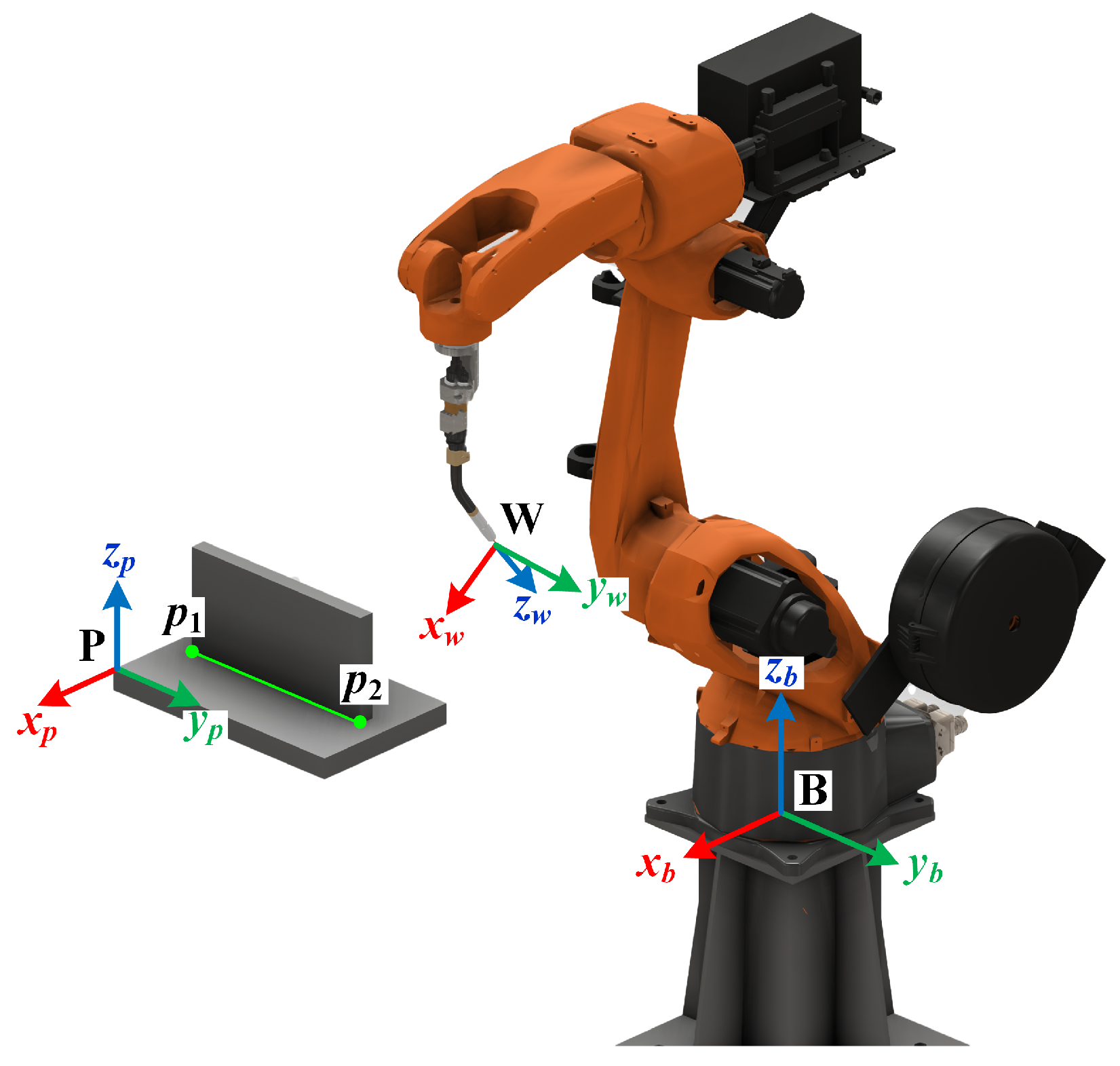A Data-Driven Approach for Energy Consumption Modeling and Optimization of Welding Robot Systems
Abstract
1. Introduction
2. Welding Robot EC Modeling
2.1. EC Analysis of Welding Robot System
2.2. Experimental Setup and Data Collection
2.3. Modeling Method
3. Welding Robot EC Optimization
3.1. Strategies to Reduce Robot EC
3.2. Optimization Method
- (1)
- Algorithm initialization: Set the population size as and the maximum number of iterations as .
- (2)
- Population initialization: Set the initial iteration step as , and initialize the initial population using the opposition-based learning strategy.
- (3)
- Optimal position selection: Calculate the fitness values of the individuals, and select the position of the individual with the optimal fitness value as the optimal position.
- (4)
- EOBL: Select the top proportion of individuals with the best fitness values as elite individuals, and calculate their reverse solutions using the elite reverse learning strategy. Select solutions with better fitness values through competition.
- (5)
- Iterative calculation: Perform iterative optimization based on random search, encircling prey, and attacking prey.
- (6)
- DE fine-tuning: Based on the current optimal solution, perform crossover and mutation operations. If a solution with better fitness is obtained, replace the current optimal solution.
- (7)
- Termination condition check: If satisfied, terminate the iteration and output the current optimal solution; otherwise, return to step (3).
| Algorithm 1 IWOA with DE and EOBL. |
| Require: Population size , max iterations , elite ratio , DE parameters , Ensure: Global best solution 1: Initialization: 2: Generate initial population using OBL: 3: 4: Set convergence factor , spiral coefficient 5: Fitness evaluation: 6: Calculate fitness for each and find 7: Elite opposition-based learning: 8: Select top elite individuals 9: For each elite , calculate reverse: 10: 11: Update using greedy selection 12: while do 13: Update , , 14: for each individual do 15: if then 16: Update position using encircling or global search 17: else 18: Update position using bubble-net attack 19: end if 20: end for 21: DE fine-tuning: 22: Generate mutant vector: 23: Perform binomial crossover and update 24: Cauchy mutation: 25: Apply perturbation to 26: Increment iteration: 27: end while 28: Return: |
4. Experimental Results and Analysis
4.1. Experimental Platform
4.2. Experimental Result
5. Conclusions
Author Contributions
Funding
Institutional Review Board Statement
Informed Consent Statement
Data Availability Statement
Conflicts of Interest
References
- Wang, B.; Hu, S.J.; Sun, L.; Freiheit, T. Intelligent welding system technologies: State-of-the-art review and perspectives. J. Manuf. Syst. 2020, 56, 373–391. [Google Scholar] [CrossRef]
- Yu, H.; Peng, Z.; He, Z.; Huang, C. Application maturity evaluation of building steel structure welding robotic technology based on multi-level gray theory. Eng. Constr. Archit. Manag. 2023, 31, 4372–4397. [Google Scholar] [CrossRef]
- Wang, X.; Xia, Z.; Zhou, X.; Guo, Y.; Gu, X.; Yan, H. Multiobjective path optimization for arc welding robot based on DMOEA/D-ET algorithm and proxy model. IEEE Trans. Instrum. Meas. 2021, 70, 1–13. [Google Scholar] [CrossRef]
- Xiao, W.; Han, G.; Ally, A.S.; Chen, X. Energy consumption modeling and parameter identification based on system decomposition of welding robots. Int. J. Adv. Manuf. Technol. 2024, 130, 1579–1594. [Google Scholar] [CrossRef]
- Pellicciari, M.; Avotins, A.; Bengtsson, K.; Berselli, G.; Bey, N.; Lennartson, B.; Meike, D. AREUS—Innovative hardware and software for sustainable industrial robotics. In Proceedings of the 2015 IEEE International Conference on Automation Science and Engineering (CASE), Gothenburg, Sweden, 24–28 August 2015; pp. 1325–1332. [Google Scholar] [CrossRef]
- Rubio, F.; Llopis-Albert, C.; Valero, F.; Besa, A.J. Sustainability and optimization in the automotive sector for adaptation to government vehicle pollutant emission regulations. J. Bus. Res. 2020, 112, 561–566. [Google Scholar] [CrossRef]
- Yao, M.; Zhou, X.; Shao, Z.; Wang, L. A general energy modeling network for serial industrial robots integrating physical mechanism priors. Robot. Comput.-Integr. Manuf. 2024, 89, 102761. [Google Scholar] [CrossRef]
- Vergnano, A.; Thorstensson, C.; Lennartson, B.; Falkman, P.; Pellicciari, M.; Leali, F.; Biller, S. Modeling and optimization of energy consumption in cooperative multi-robot systems. IEEE Trans. Autom. Sci. Eng. 2012, 9, 423–428. [Google Scholar] [CrossRef]
- Liu, A.; Liu, H.; Yao, B.; Xu, W.; Yang, M. Energy consumption modeling of industrial robot based on simulated power data and parameter identification. Adv. Mech. Eng. 2018, 10, 1687814018773852. [Google Scholar] [CrossRef]
- Meike, D.; Pellicciari, M.; Berselli, G. Energy efficient use of multirobot production lines in the automotive industry: Detailed system modeling and optimization. IEEE Trans. Autom. Sci. Eng. 2013, 11, 798–809. [Google Scholar] [CrossRef]
- Zhou, J.; Yi, H.; Cao, H.; Jiang, P.; Zhang, C.; Ge, W. Structural decomposition-based energy consumption modeling of robot laser processing systems and energy-efficient analysis. Robot. Comput.-Integr. Manuf. 2022, 76, 102327. [Google Scholar] [CrossRef]
- Li, X.; Lan, Y.; Jiang, P.; Cao, H.; Zhou, J. An efficient computation for energy optimization of robot trajectory. IEEE Trans. Ind. Electron. 2021, 69, 11436–11446. [Google Scholar] [CrossRef]
- Heredia, J.; Schlette, C.; Kjærgaard, M.B. Data-driven energy estimation of individual instructions in user-defined robot programs for collaborative robots. IEEE Robot. Autom. Lett. 2021, 6, 6836–6843. [Google Scholar] [CrossRef]
- Yao, M.; Zhao, Q.; Shao, Z.; Zhao, Y. Research on power modeling of the industrial robot based on ResNet. In Proceedings of the 2022 7th International Conference on Automation, Control and Robotics Engineering (CACRE), Xi’an, China, 14–16 July 2022; pp. 87–92. [Google Scholar] [CrossRef]
- Zhang, M.; Yan, J. A data-driven method for optimizing the energy consumption of industrial robots. J. Clean. Prod. 2021, 285, 124862. [Google Scholar] [CrossRef]
- Yan, J.; Zhang, M. A transfer-learning based energy consumption modeling method for industrial robots. J. Clean. Prod. 2021, 325, 129299. [Google Scholar] [CrossRef]
- Jiang, P.; Wang, Z.; Li, X.; Wang, X.V.; Yang, B.; Zheng, J. Energy consumption prediction and optimization of industrial robots based on LSTM. J. Manuf. Syst. 2023, 70, 137–148. [Google Scholar] [CrossRef]
- Lin, H.I.; Mandal, R.; Wibowo, F.S. BN-LSTM-based energy consumption modeling approach for an industrial robot manipulator. Robot. Comput.-Integr. Manuf. 2024, 85, 102629. [Google Scholar] [CrossRef]
- Gadaleta, M.; Pellicciari, M.; Berselli, G. Optimization of the energy consumption of industrial robots for automatic code generation. Robot. Comput.-Integr. Manuf. 2019, 57, 452–464. [Google Scholar] [CrossRef]
- Soori, M.; Arezoo, B.; Dastres, R. Optimization of energy consumption in industrial robots, a review. Cogn. Robot. 2023, 3, 142–157. [Google Scholar] [CrossRef]
- Luo, X.; Li, S.; Liu, S.; Liu, G. An optimal trajectory planning method for path tracking of industrial robots. Robotica 2019, 37, 502–520. [Google Scholar] [CrossRef]
- Li, Y.; Wang, Z.; Yang, H.; Zhang, H.; Wei, Y. Energy-optimal planning of robot trajectory based on dynamics. Arab. J. Sci. Eng. 2023, 48, 3523–3536. [Google Scholar] [CrossRef]
- Gadaleta, M.; Berselli, G.; Pellicciari, M.; Sposato, M. A simulation tool for computing energy optimal motion parameters of industrial robots. Procedia Manuf. 2017, 11, 319–328. [Google Scholar] [CrossRef]
- Wang, X.; Yan, Y.; Gu, X. Spot welding robot path planning using intelligent algorithm. J. Manuf. Process. 2019, 42, 1–10. [Google Scholar] [CrossRef]
- Mitra, A.; Bhowmik, S.; Chowdhury, S. V/f Control of PMSM Drive fed from PR Current Controller Based Single-Phase AFE Rectifier. In Proceedings of the 2024 IEEE 3rd International Conference on Control, Instrumentation, Energy & Communication (CIEC), Kolkata, India, 25–27 January 2024; pp. 337–342. [Google Scholar] [CrossRef]
- Garcia, R.R.; Bittencourt, A.C.; Villani, E. Relevant factors for the energy consumption of industrial robots. J. Braz. Soc. Mech. Sci. Eng. 2018, 40, 1–15. [Google Scholar] [CrossRef]
- Jia, B.; Chen, L.; Zhang, L.; Fu, Y.; Zhang, Q.; Pan, H. Vibration suppression of welding robot based on chaos-regression tree dynamic model. Nonlinear Dyn. 2024, 112, 4393–4407. [Google Scholar] [CrossRef]
- Sheng, C.; Yu, H. An optimized prediction algorithm based on XGBoost. In Proceedings of the 2022 International Conference on Networking and Network Applications (NaNA), Urumqi, China, 3–5 December 2022; pp. 1–6. [Google Scholar] [CrossRef]
- Mirjalili, S.; Lewis, A. The whale optimization algorithm. Adv. Eng. Softw. 2016, 95, 51–67. [Google Scholar] [CrossRef]













| Movement Type | Tests Velocity |
|---|---|
| PTP/(%) | 2, 5, 8, 10, 15, 20, 30, 40, 50, 70 |
| Linear motion/(mm/s) | 2, 4, 6, 8, 10, 15, 20, 30, 50, 75, 100, 150, 200, 300, 500 |
| Circular motion/(mm/s) | 2, 4, 6, 8, 10, 15, 20, 30 |
| Model | MSE | MAE/(W) | MAPE | |
|---|---|---|---|---|
| Regression Tree | 0.0025 | 0.96 | 5.3021 | 0.0186 |
| Linear Regression | 0.0371 | 0.43 | 28.6886 | 0.0962 |
| Neural Networks | 0.0064 | 0.90 | 11.1324 | 0.0370 |
| Regression Tree Ensemble | 0.0024 | 0.96 | 6.2041 | 0.0211 |
| XGBoost | 0.0012 | 0.98 | 3.8723 | 0.0131 |
| Parameters | Value |
|---|---|
| Number of axes | 6 |
| Load | 8 kg |
| Body weight | 190 kg |
| Maximum arm span | 1465 mm |
| Maximum power | 4 kW |
| Repetitive positioning accuracy | ±0.08 mm |
| Restriction Type | Joint 1 | Joint 2 | Joint 3 | Joint 4 | Joint 5 | Joint 6 |
|---|---|---|---|---|---|---|
| Joint position/(°) | −90∼90 | −45∼75 | −55∼75 | −85∼35 | −60∼35 | −300∼300 |
| Joint velocity/(°/s) | 170 | 420 | 440 | 860 | 860 | 1300 |
| Joint acceleration/(°/s2) | 1700 | 4200 | 3440 | 5840 | 6080 | 11,200 |
| Restriction Type | x/(mm) | y/(mm) | z/(mm) | Rz/(°) |
|---|---|---|---|---|
| Workpiece coordinate position | 350∼1000 | −800∼800 | 400∼1200 | −90∼90 |
| Item | Workpiece Coordinate Position (x, y, z, Rx, Ry, Rz) | Algorithm Execution Time | Predicted /(J) | Predicted /(J) |
|---|---|---|---|---|
| Before optimization | (420, 450, 1150, 0, 0, 30) | - | 38,965.35 | 579.86 |
| Minimization of | (350.30, −659.31, 890.35, 0, 0, −55.96) | 1590 s | 37,020.31 | 554.21 |
| Minimization of | (703.97, −161.84, 1003.01, 0, 0, −13.82) | 1648 s | 36,178.21 | 559.65 |
| Item | /(°/s) | /(°/s) | /(°/s) | /(°/s) | /(°/s) | /(°/s) |
|---|---|---|---|---|---|---|
| Before optimization | 1.19 | 1.62 | 1.69 | 0.66 | 0.82 | 4.68 |
| Minimization of | 1.05 | 1.54 | 1.60 | 0.70 | 0.90 | 4.47 |
| Minimization of | 1.07 | 1.61 | 1.65 | 0.76 | 0.88 | 4.56 |
| Item | Actual /(J) | Actual /(J) | MAE Between Predicted and Actual Power/(W) | Average Power of the /(W) |
|---|---|---|---|---|
| Before optimization | 39,911.59 | 599.76 | 7.14 | 257.24 |
| Minimization of | 38,282.80 | 573.82 | 6.82 | 246.74 |
| Minimization of | 37,230.33 | 580.64 | 7.34 | 239.96 |
Disclaimer/Publisher’s Note: The statements, opinions and data contained in all publications are solely those of the individual author(s) and contributor(s) and not of MDPI and/or the editor(s). MDPI and/or the editor(s) disclaim responsibility for any injury to people or property resulting from any ideas, methods, instructions or products referred to in the content. |
© 2025 by the authors. Licensee MDPI, Basel, Switzerland. This article is an open access article distributed under the terms and conditions of the Creative Commons Attribution (CC BY) license (https://creativecommons.org/licenses/by/4.0/).
Share and Cite
Pan, M.; Jia, B.; Zhang, L.; Pan, H.; Chen, L. A Data-Driven Approach for Energy Consumption Modeling and Optimization of Welding Robot Systems. Machines 2025, 13, 532. https://doi.org/10.3390/machines13060532
Pan M, Jia B, Zhang L, Pan H, Chen L. A Data-Driven Approach for Energy Consumption Modeling and Optimization of Welding Robot Systems. Machines. 2025; 13(6):532. https://doi.org/10.3390/machines13060532
Chicago/Turabian StylePan, Minling, Bingqi Jia, Lei Zhang, Haihong Pan, and Lin Chen. 2025. "A Data-Driven Approach for Energy Consumption Modeling and Optimization of Welding Robot Systems" Machines 13, no. 6: 532. https://doi.org/10.3390/machines13060532
APA StylePan, M., Jia, B., Zhang, L., Pan, H., & Chen, L. (2025). A Data-Driven Approach for Energy Consumption Modeling and Optimization of Welding Robot Systems. Machines, 13(6), 532. https://doi.org/10.3390/machines13060532







